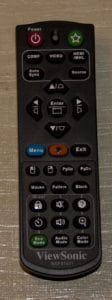The next section of the remote control are three source buttons – the leftmost one – labeled Comp, toggles between Computer, and Component Video, the middle button toggles between S-Video and composite video, and the right button HDMI, toggles between the HDMI1 on the back panel and the HDMI2 with MHL in the interior compartment.
Below that is the auto-sync button for analog computers and a Source button which brings up the list of sources.
Further down are the four navigation buttons, with Enter in the middle. Like with the control panel, the top and bottom ones double as keystone correction, but on the remote, the left and right buttons control horizontal keystone correction.
Right below the navigation area on the left is the Menu button, the Laser button is in the middle, and Exit on the right.
Below that, left and right mousing controls and Page Up, Page Down (a business/education basis).
Wait, there’s more. The next row has the Mousing button to engage remote mousing, a focus pattern and screen Blank.
The bottom section starts on the left with the Control Panel lock button has speaker mute and volume, timer, digital magnifier. Finally, the bottom row: ECO mode, Audio Mode, and Color Mode buttons for direct access.
That whole bottom section doubles as a numeric keypad for password control.
That’s about it. Hard to cram 29 buttons on a small remote, but Viewsonic did it. For those of you using this projector for home use only, you won’t need a number of them, but if you bought for business, or classroom, or for both home and business, enjoy all the features. But, I still believe home users would really have appreciated a backlight!


